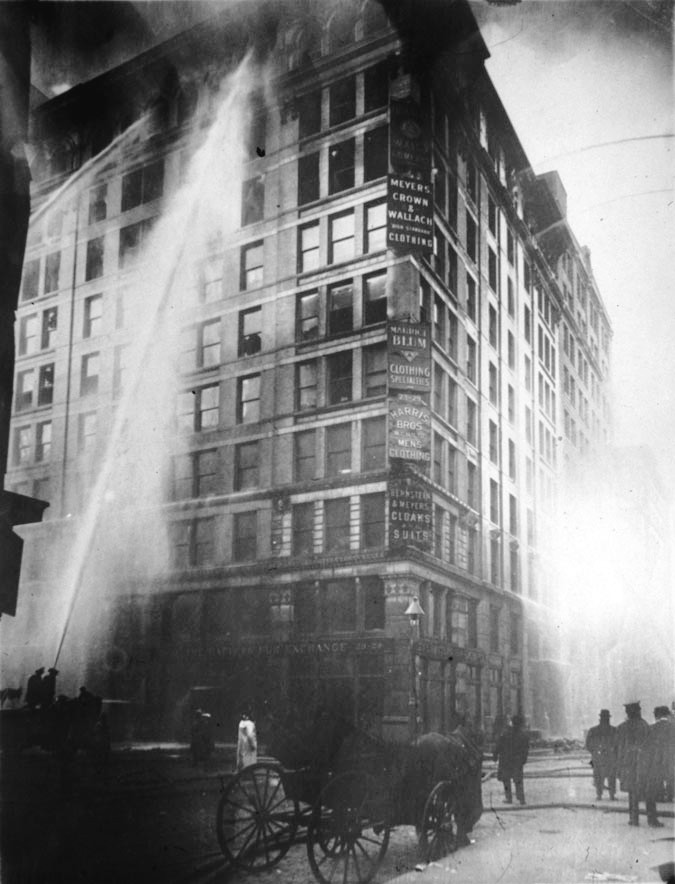It was March 25, 1911, in New York City. It was a Saturday afternoon just like any other at the Triangle Shirtwaist factory, where young immigrant women sat in front of sewing machines, day in and day out, sewing. But on that day a fire broke out, causing the deaths of 146 garment workers. Among those who died in the flames and smoke were 123 women and 23 men.1 Many even jumped or fell to their deaths out the windows, making this event a man-made disaster and one of the deadliest industrial disasters of all time.

The factory was located in the Asch Building at Washington Place in Greenwich Village, one of the wealthiest neighborhoods in the city. The factory occupied the eighth, ninth, and tenth floors of the ten-story building. Max Blanck and Issac Harris were the owners of the factory, and their company was known as the largest firm in the business at the time. They styled women’s blouses known as “Shirtwaists,” which were paired with tailored skirts. This attire had become the standard in fashion for women in the early twentieth century. They were also known to resemble men’s shirts. When it came to their workers, they had hired operators who then contracted out for factory workers. The company itself only dealt with the contractors, and there was no fixed rate of pay for the workers.2 At the time, the factory employed about five-hundred employees, mostly young immigrant women who were of Italian or Jewish descent. These women worked up to eleven-hour shifts on weekdays, and twelve-hour shifts on Saturdays, and they earned between $7-$12 dollars for a 52-hour week. Many of these women were the breadwinners of their household, and their income was sometimes not sufficient to cover their needs.
Towards the end of the workday on that Saturday evening in 1911, a fire broke out around 4:00 pm. The fire started in a scrap bin under one of the cutter’s tables on the eighth floor from what is believed to have come from a cigarette. A manager tried to put the fire out with a hose but the hoses valve was rusted shut, and rotten away. The fire spread quickly and the workers panicked. There was one fire escape that quickly collapsed, and four elevators, which out of the four only one was working. The elevator held twelve people at a time, and it managed to make four rescue trips before it broke down.3 With no other alternatives available, people began throwing themselves out the windows, and some were even crushed to death trying to get out. Workers tried to take the stairs, but the exit doors only opened inward and were kept locked by factory management to prevent theft by the workers, as the managers would check their workers belongings every day before they left for the day.

Celia Saltz Pollack, a survivor of the 1911 Triangle Shirtwaist Fire said,
I remember on that day there was a lot of singing and happiness in the shop because it was the end of the week and we got paid. We were soon all going to go home. When the fire started I was sitting at my machine. I looked up and saw the fire near the cutting tables but I did not think it was so terrible. What was terrible was that the fire spread in a split second.
By the time the firefighters arrived, they came to the realization that their ladders could only extend up to the sixth or seventh floors. With no other option, sixty-two workers jumped and fell to their deaths, while the remaining died from the smoke and flames within the building.4

This fire not only pushed issues of unsafe factories and immigrant exploitation into the public consciousness, but for the first time the fire allowed for attention to be brought to deplorable conditions of New York factories.5 Women obtained well deserved attention onto current work conditions and safety measures in the workplace. Although the Triangle Shirtwaist Factory fire brought a feeling of resentment and heartbreak to many, this event and its victims will always be remembered.
- Ric Burns, “Triangle Shirtwaist Fire,” New York Times (1923-Current File), Nov 24, 1999. ↵
- Jonathan Fink, “Conflagration and Wage: The Triangle Shirtwaist Factory Fire, 1911,” TriQuarterly, no, (2009): 135-136. ↵
- Gale Encyclopedia of U.S. Economic History, s.v. “Triangle Shirtwaist Fire,” by Thomas Carson and Mary Bonk. ↵
- Mia Lynn Mercurio, Régine Randall, “Tributes Beyond Words: Art Educators’ Use of Textiles to Memorialize the Triangle Shirtwaist Factory Fire.” Journal for Learning through the Arts no. 1 (2016): 4-5. ↵
- Albert Marrin, Flesh and blood so cheap: The Triangle fire and its legacy (New York: Alfred A. Knopf, 2011), 23-25. ↵




135 comments
Michael Thomas
This article was informative because of how the Triangle Shirtwaist Factory fire led to the change in conditions of the factory. It is disappointing that many lives were lost during the fire due to terrible work conditions. If the owners improved the conditions of the factory and created a proper protocol for fire emergencies, then the number of lives lost would be reduced.
Hanadi Sonouper
The article expressed the saddening tale of workers coming to a sudden death due to the unfortunate working conditions of the early New York era. The hardworking gentleman and ladies who spend a good portion of their lives working in a poor environment have suffered enough to dictate that their treatment is way below standards. The author does an excellent job at portraying the story from 1911 to express full detail and anguish that took place as these innocent immigrants and working class endured as they jumped out the window, or burned to death. This event certainly has raised the expectations of working conditions as the years progressed, to protect the factory workers to better working conditions and a much more beneficial pay. The fact of equality has to be risen and held up to standards, because in the end they are all human beings in America trying to make a living for themselves, trying to mesmerize the big picture of achieving the American dream.
Destiny Flores
To put yourself mentally into the mind of a worker when this fire broke out, is a true nightmare. Its a horrible thought that these men and women were exploited, given horrible wage, no benefits, and were failed by their employer to be provided with decent emergency protocols. It brings to light the theory that movements or changes aren’t made or paid attention to until people die for it-and that is devastating.
Alise Balderas
The horror that these people had to face are unthinkable and it saddens me. It is a real life nightmare. These people are true heroes. This article was very informative and it is heartbreaking. The thing that bothers me the most about this incident is that everything could have been avoided. It is crazy to think that the workers were inside with locked doors the entire day. I guess it takes a tragedy like this one for people to learn from their mistakes and it is a very sad reality.
Clarissa Bustamante
It is crazy how such a tragic event occurred, this article was very interesting and well written with such great detail. I do not think that I heard about this disaster growing up but thinking about it now I believe that it is great and smart to have all the rules and regulations placed in factories or any working facility today. By having this rules and regulations it ensures that nothing like this ever happens again. Overall, this article was great.
Auroara-Juhl Nikkels
Previous to reading your article, I had no idea this event even happened. It makes me wonder what other tragedies have happened in our history that we have no idea about. One part of your article that really caught my attention was that the managers kept the exit doors locked from the outside. If those doors had been unlocked, many lives that day could have been saved.
Cherice Leach
The use of the images in this article really helps to hammer home the horror and dread of the disaster. The images were well selected to convey the overall tone of the article as one displaying a terrible accident caused by several little “hiccups” piling up into the disaster that claimed so many lives. I can only imagine how frightening it must have been to be there on that day.
Alejandra Mendez
Although I have never head of the disaster in the triangle shirtwaist factory, it is a very tragic event. It is all very sad, but it is always good when at least some positive things result from these kinds of tragedies. It is because of this event that more regulations were places on factories to prevent the same incidents from having to happen again. It is always better safe than sorry especially when working in such conditions and environments such as a factory’s.
Ryann Cervantes
Rereading this article I think what really struck me was how undeserving these people were of that terrible incident. They worked 50 hour weeks, 6 days a weak for small pay and were the primary laborers for their families. They worked so hard to earn so little and the unsafe and untrustworthy conditions of the factory ultimately led to their demise. It is really tragic.
Mariet Loredo
This was such a tragic story, I remember learning about this in high school. It sad knowing that these women and men were treated so unfairly. They were treated like prisoners, locking the doors during the work day to prevent them from stealing, but not locking the door could of saved many lives. Working conditions have changed a lot, making it safer for employees so a tragedy like this does not happen again.